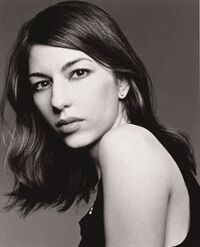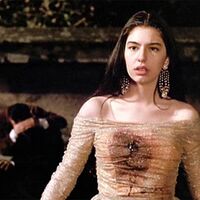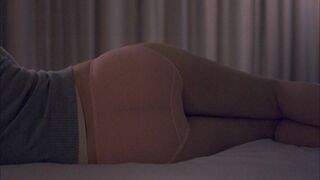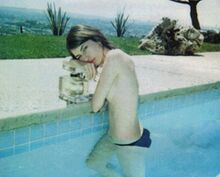Sofia Coppola
Sofia Coppola (born May 14, 1971) is an American director, screenwriter and occasional actor who makes films about nothing.
Early life
Coppola was born in New York City, New York, the youngest child and only daughter of Eleanor Neil and Francis Ford Coppola, granddaughter of the composer Carmine Coppola, sister of Roman Coppola and Gian-Carlo Coppola, niece of August Coppola and Talia Shire, cousin of Nicolas Cage, Jason Schwartzman and Robert Carmine, goddaughter of Al Pacino and Diane Keaton, pen-pal of Steven Spielberg, fuckbuddy of Andy Garcia and bitter enemy of Kathryn Bigelow.
Her young life involved nothing but the tedium of being a pretty rich girl wandering around a vast, empty mansion while her parents were off making something of themselves.
Coppola spent her teenage years flitting from luxurious hotel room to luxurious hotel room, gazing longily into mirrors and muttering occasional syllables to the other lost souls who passed by. When she wasn't making a fleeting nepotistic cameo in one of her father's films, she spent her time wallowing in despair. Such empty, sexy despair.
Her best known acting role is Mary Corleone in The Godfather Part III, which she was cast for by her father after Winona Ryder became far too bribed to show up. She spent most of her time on-set just hanging around looking pretty, and waiting for daddy to yell "action!" She realized around this time that acting is just 10% acting and 90% waiting, an observation she decided was incredibly profound and had to write on the front of her diary.
Filmmaking
Lick the Star
Eventually, she decided to start doing something with her life, and made a short film called Lick the Star. It follows a clique of four beautiful rich girls as they hang around school talking about boys and issues. It is shot entirely in black and white for all the usual artistic reasons people photograph things in black and white, and also because Coppola thought it looked pretty.
Coppola screened the film in a New York auditorium to an audience made up of just herself looking glum, where it received a lukewarm reception. The footage of her watching it was used as behind-the-scenes footage on the DVD, and was probably less tedious to watch than the actual film.
The Virgin Suicides
The Virgin Suicides was Coppola's first full-length feature. It tells the story of five young, beautiful sisters who inexplicably commit suicide by jumping out of their bedroom window, presumably to escape the desolate suburban malaise of their life of solitary privilege.
With this film, Coppola began to set in place the trademarks that would follow her throughout her career. The most notable of these is the slow, laborious pacing of a story in which barely anything happens. Although it does have some nice photography.
The director attended various press conferences to promote the film, although she didn't actually say anything and instead just sat there looking sad but hot.
Lost in Translation
Coppola's next film, Lost in Translation was a sparse comedy-drama with little plot and a sluggish pace, dealing with themes such as isolation, existentialism, culture shock and urban alienation. No surprise there then. It starred Bill Murray and Scarlett Johansson as two lonely but handsome insomniacs who develop a unique closeness while staying in the same exquisitely-photographed Tokyo hotel. And that's about it for narrative.
In a true riches-to-riches story, the film was critically acclaimed upon release and earned Coppola an Academy Award for Best Screenplay. When she reached the Oscar podium she was so overjoyed that she had to take a picture of herself looking pensive. She was also nominated for Best Director but lost to Peter Jackson's latest four-hour battle scene. Coppola was so disappointed by the loss that she had to take a picture of herself looking pensive.
Music video for The White Stripes' "I Just Don't Know What to Do with Myself"
In 2003 Coppola also directed a music video for the ultra-hip band The White Stripes. The whole clip was just a shot of supermodel Kate Moss dancing half-naked in a big empty room, filmed in a crisp, resplendent monochrome. Coppola called it "semi-autobiographical; my best work to date".
Marie Antoinette
Next, Coppola wrote and directed a historical biopic very loosely based on the life of rich, lonely and gorgeous Queen Consort of France, Marie Antoinette. While lots of interesting things happened to the young queen in her short life, Coppola decided to skirt over these in favour of scenes where Marie wanders the long empty corridors of her massive palace looking sexy and disappointed.
Like many of her films, Marie Antoinette was also littered with alternative pop songs from the 70s and 80s, which had nothing to do with the film's plot or atmosphere but make the viewer reflect on how they used to love that song - a subtle tactic that makes the film appear more entertaining than it really is.
In contrast to her other works critics despised the film, although on close examination it had the exact same story, characters, setting and themes as all of the others. The only difference was that it was set in the past, and even that was made to look like an MTV music video.
Somewhere
The most recent film directed by Coppola follows the life of famous actor Johnny Marco, played by not-so-famous Stephen Dorff, who despite his money and fame is trapped in an existential crisis and feels little emotion during his daily life. Then in a dramatic twist his long lost daughter shows up, with nonexistent results.
With its lack of narrative and long takes of nothingness, Somewhere was a welcome return to more familiar territory for Coppola, or at least it would have been had she departed this territory at any point.
The film received mostly positive reviews and won the Golden Lion at the Venice Film Festival; Coppola was said to be absolutely impartial when she heard the cool news, and celebrated by staying at home in her underwear not being able to sleep.
Personal Life
In her spare time Coppola does nothing. She's nice to look at though.
See Also
| Featured version: 7 June 2011 | |
| This article has been featured on the main page. — You can vote for or nominate your favourite articles at Uncyclopedia:VFH. | |





